Going Thirsty: A Plea for More Drinking Fountains
In the past few years, Raleigh has been fortunate and invested in public-use infrastructure projects. This includes the installation of new benches, shelters, sidewalks, and other related items. Noticeably absent from these improvements (outside of public parks), is the outdoor drinking fountain.
As Raleigh continues to improve the experience of pedestrians, cyclists, joggers, bus riders, and others, it should consider adding more outdoor drinking fountains to address mankind’s most primitive need: thirst.
A Brief Look at the History of Outdoor Drinking Fountains
Public drinking fountains have been around since the dawn of human civilization. In fact, they were often the yardstick used to gauge whether an urban area had been “civilized.”
Public drinking infrastructure started with simple stone basins made by the Sumerians to more sophisticated gravity-powered systems used by the Greeks, Romans, and Islamic civilizations. Most of these systems fell into disrepair and largely disappeared from Europe during the Dark Ages. Revived during the Renaissance, they have been improved upon ever since.
Drinking Fountains in the 20th Century
Although there were public sources of drinking water at the turn of the century, many were unsanitary and the source of illness:
The drinking fountain, as we know it, was developed in the early 1900s by Halsey Taylor and Haws. These two companies, founded by Halsey Willard Taylor and Luther Haws respectively, pioneered a major change in how water was dispensed in public places. In doing so, they also helped reduce the instance of waterborne diseases among the general population. In fact, Halsey W. Taylor’s dedication to providing a safe and sanitary drink to the public was prompted by his father’s death from typhoid fever caused by a contaminated water supply.
A Look at What’s Left in Raleigh Today
I know of five outdoor drinking fountains in Raleigh that are not within a city park: three on Capitol Square, one not far away on Halifax Mall, and one on the NC State campus. Of these, only one works: the one engaged via a foot pump on Capitol Square. Those fountains were probably installed in the 1920s or 1930s.
The other fountain is located on Halifax Mall and is of the same design as one of the three located on Capitol Square. Considering that all of the buildings around it are much newer, it was likely relocated in the 1970s when the Mall was built. Although it features a modern activator button on the front, it is currently non-operational.
Another non-working drinking fountain can be found at NC State. Near Primrose Hall off of Hillsborough Street, this granite fountain was a gift from the 1914 graduating class and has been moved since it was built. I’m not sure when it stopped functioning as a source of water.
To learn more about this fountain, please read How N.C. State’s 1914 Stone Fountain Became a Planter.
The Exception: City Parks
Outdoor drinking fountains have been installed in Raleigh in recent years. Unfortunately, as far as I can tell, the only recipient of these fountains are the destination parks managed by Raleigh Parks and Recreation.
While it’s great that these are here, they primarily serve the needs of those that traveled specifically to the park. They usually aren’t along common paths used by joggers, pedestrians, bus riders, and cyclists.
Placing new drinking fountains in strategic locations in the city could go a long way to encouraging people to be more active. More drinking fountains mean more options for runners and pedestrians–it’s not always practical to carry a bottle of water with you.
A Glaring Omission in the Moore Square Master Plan
If I had to name the place that was most in need of a drinking fountain, it would be Moore Square. I was surprised and disappointed to see that although the Moore Square Master Plan includes a play fountain and an outdoor Café, there are no drinking fountains. I sincerely hope that this is simply an oversight and will be in the final design of the new Moore Square.
City Plaza also makes for a deserving location. There are light sculptures, shops, and a decorative motion activated water fountain–but no water to drink. While I appreciate the City’s investment into public art, water for drinking should come before water as decoration. One could be creative about the installation and solve both problems with one structure.
A Big Win For Everyone
The biggest use case I see for more drinking fountains are the numerous downtown festivals. Hopscotch, SPARKcon, Raleigh Wide Open, among others would benefit tremendously from more available drinking fountains. Walking around large crowds in an urban jungle quickly depletes internal fluids and it’s not always convenient to buy a soda or bottled water.
Having more drinking fountains would also encourage more outdoor exercise, by allowing joggers to stay hydrated. It would help cool down riders of public transportation that must wait for buses in the sun and car exhaust.
Although there are maintenance costs involved, drinking fountains can be found for $1,500. Put in the perspective of costs associated with streetscape improvements, it is well worth the investment.
Suggest it to City Planners and Leaders
The City of Raleigh is conducting an online survey to help develop a Comprehensive Pedestrian Plan. It runs for the next few days (ending June 30), and I hope you’ll take the short survey to provider planners with what is most beneficial to you.
There are several open-ended questions on how to improve the pedestrian experience. If you feel that the addition of more water fountains in pedestrian areas would be beneficial to you, I encourage you to mention it.
Take the survey for the City of Raleigh Comprehensive Pedestrian Plan >

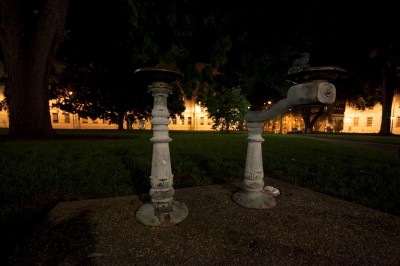
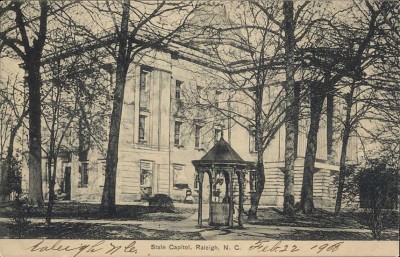
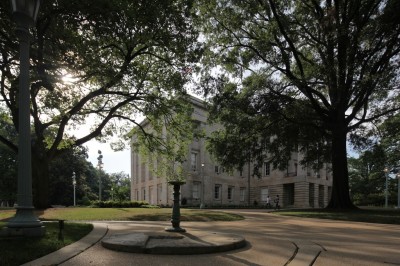
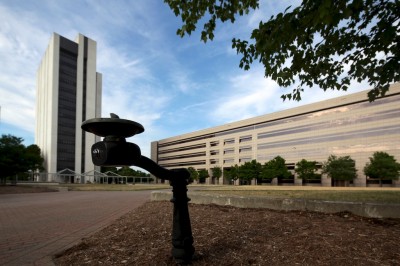
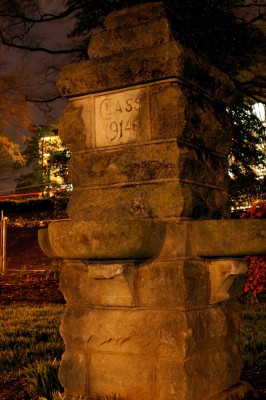

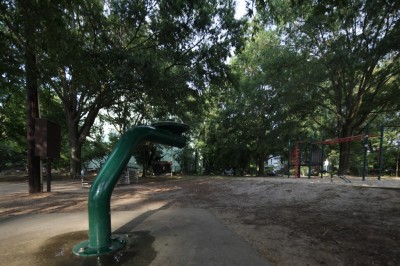
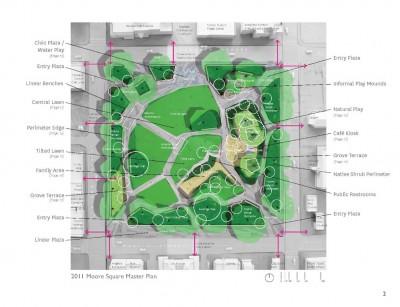
 Sign up for the Newsletter
Sign up for the Newsletter
06/27/2011
No, water fountains are an unnecessary expence unless located at parks.
06/27/2011
John, there is a water fountain (and I think there is actually 2) in the little courtyard/picnic area behind the State Library of NC building. I stopped on Sunday while out for a run, and was surprised to find that it was actually functional.
http://maps.google.com/maps?q=35.783462,-78.637509&ll=35.783367,-78.637771&spn=0.003851,0.004174&sll=37.0625,-95.677068&sspn=23.875,57.630033&num=1&t=h&z=18
06/27/2011
Thanks for posting this! I was just lamenting the lack of water fountains to Leo the other day. Definitely a need if you want to bring more people down here for summer events.
06/27/2011
I’ve always considered it a “local” honor in knowing where to find the working fountain-on-the-left on the Capitol grounds. It also seems that of the 3 antique fountains there, most have been augmented with a few modern parts over the years. It would be great to see them even slightly restored or just polished. Another non-drinking water feature I would love to see fixed is the two water bowls flanking the NC Presidents’ statue (east side of the grounds). They haven’t been operational for at least 3-4 years in my memory. Possibly turned off during the serious drought a few summers ago, but I can’t imagine they use much water. Anyone remember the last time they flowed?
06/29/2011
I just watched the movie Tapped (an instant play on Netflix) so I couldn’t agree more with this post. The alternate to water fountains are water bottles, and too many people use plastic one-time-use ones, which are bad on so many levels.
Thanks for the info on the city survey. I caught it just in time!
07/18/2011
Honestly, I think it should be a federal law that there should always be at least one drinking fountain in every public park. I was walking in 100 degree heat today. I went to the park, thinking that the park of all places would have a drinking fountain. Nope. By that point, I started to feel extremely woozy and couldn’t think straight. There was absolutely no one playing. Everyone was sitting out or enjoying the (gated) pool. I’m alright now, but it took me a half-hour to walk home in a journey that usually takes 10 minutes. My question is, why on earth would you not have a drinking fountain in a park? It’s ridiculous that you wouldn’t. And considering how many people collapse of heat exhaustion, this is a necessity.
07/19/2011
I stopped at one a few months ago on the Halifax Mall. It didn’t work. :-(